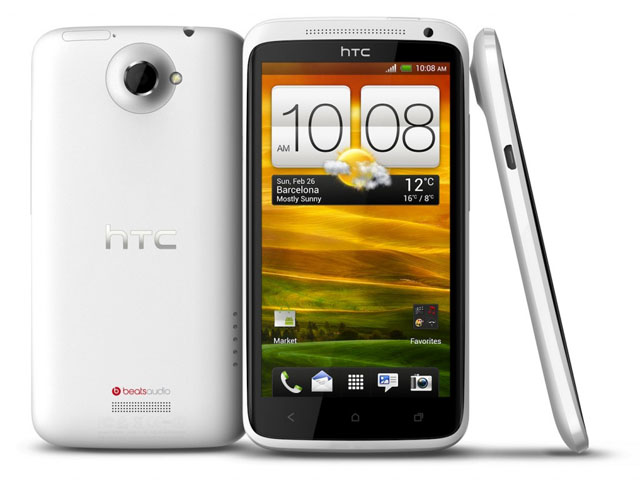
review Bigger, faster and brimming with features, HTC’s One X strikes a major blow in the Android arms race.
Design
HTC’s One X sports a very generous 4.7-inch display, yet manages to retain an elegant look and feel. It’s only 8.9mm thick and weighs in at an impressive 130gm thanks to the polycarbonate unibody design with the slightest of curves which should still fit most pockets.
Under the bonnet beats one of the first 1.5GHz quad-core smartphone processors — the NVIDIA Tegra 3 — accompanied by 1GB of RAM. Menus are silky smooth and apps load very fast, but not all apps can take full advantage of all those cores. Even graphics intensive games don’t see a major boost, but that will come. For now the grunt shines through when multi-tasking and it offers a certain level of future-proofing.
The One X’s other claim to fame is that it’s one of the first Australian phones to run Android 4.0 “Ice Cream Sandwich” out of the box, following in the footsteps of the Samsung Galaxy Nexus. This is not the place for a detailed ICS review, but it’s worth noting that HTC Sense 4.0 adds some handy tweaks and is less intrusive on ICS (plus it’s faster thanks to the quad-core processor). Yet HTC doesn’t bundle as many extra apps and services as Samsung does.
Features
Fire up the One X and you’re presented with a bright, crisp 1280×720 Super LCD display. It offers an impressive 312 dots per inch, falling only a tad short of the iPhone 4S’ retina display. Some people prefer vivid AMOLED screens, but LCD offers more accurate colours and whiter whites which improve the contrast to help combat outdoor glare.
The ultrasharp display and beefy powerplant are put to good use with the One X’s impressive multimedia features. It sports a 1.3MP front camera and 8MP rear camera, that latter of which is not only sharp but boasts impressive low-light performance thanks to an f/2.0 lens (assisted by a dedicated chip for image processing). Put to the test this translates into not only sharper low-light images but less speckle in the shadows (known as “noise”) and more accurate colours. You’ll also enjoy 1080p video recording and 720p video chat.
Music lovers might appreciate the One X’s Beats Audio logo, although HTC has stopped shipping Beats Audio-certified headphones. Using the supplied headphones I still noticed that music sounded richer with Beats Audio enabled. But even when disabled the sound wasn’t too bad, about on par with the sound from an iPhone 4 using the same HTC headphones. To be honest audiophiles who would appreciate the difference have probably already invested in high-end earbuds or headphones.
The phone also supports Bluetooth 4.0 with aptX for improved audio quality. Add to this 802.11 b/g/n Wi-Fi with 2.4 and 5GHz support. You’ll also find micro-USB but not a micro-SD slot — a sacrifice that’s becoming more common with the move to ultra-slim designs (along with a non-replaceable battery). Thankfully there’s a generous 32GB of onboard storage. You can buy a USB to HDMI adaptor, plus the contact points on the back of the phone support an HDMI-enabled charge cradle (which you might need to import).
To top things off the phone features NFC for close-range wireless transactions. HTC was showing off the NFC features at the phone’s launch, but we’re still waiting for the technology to reach critical mass in Australia (which sadly may not be until the iPhone comes to the party).
About the only area where this handset isn’t pushing the envelope is mobile broadband. The One X doesn’t support LTE or DC-HSDPA, but you’ll find LTE in the One XL which Telstra is launching soon. The trade-off for the One XL’s LTE goodness is a dual-core processor rather than quad-core. It’s interesting to note the One X is a quad-band HSDPA device supporting both 850 and 900MHz (relying on a micro-SIM card). This is good news for Vodafone customers, as they can tap into the 850MHz metro rollout. The phone supports HSDPA “up to 21 Mbps”, which means real-world speeds of up to 10-ish Mbps (obviously your mileage may vary depending on your network).
Performance
The One X had trouble running the Rightware Browsermark but eventually returned results between 84,505 and 91,753 — putting most Android devices to shame. It’s worth noting that Samsung’s Galaxy Nexus outguns in at 96,015, even though the Nexus only packs a dual-core 1.2GHz Texas Instruments powerplant. It’s a reminder that performance is more than a numbers game. What’s interesting is the One X also includes a fifth core, letting the phone drop back into single-core power-saving mode when you don’t need all that extra grunt. Even with this, the battery life is mediocre and power users could be running on fumes by the end of the day.
Conclusion
That’s a lot of ground covered and we’ve really just scratched the surface. It’s still early days for Ice Cream Sandwich and quad-core processors and we can expect more great handsets this year, but for now we’d say HTC’s One X is the new gold standard in Android superphones. For now the One X is available in Australia on Vodafone, Optus and Virgin starting at around $59 per month. They’re not offering outright pricing, but if you look around online you’ll find an $899 RRP but it sells for less.
Adam Turner walked away from an old-school newsroom to embrace his inner geek and become a freelance technology journalist. With a passion for mobile gadgets and the digital lounge room, Adam’s on a quest to attain oneness with technology.
Image credit: HTC

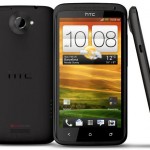
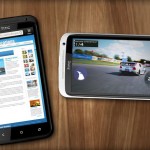

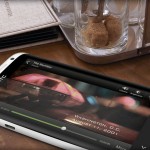

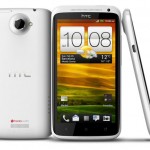
The dual-core variant packs a next-gen snapdragon S4 CPU, which is more than twice as powerful per core than the Tegra 3. It’s definitely the superior SoC.
Nice easy read. You got lots of info in there without needing a spec list – cool.
Adam, I’m wondering who you would recommend this phone to? In place of, say, a Galaxy Nexus or iPhone.
People that want the latest hardware and don’t mind HTC’s Sense UI, I guess, would be a good target.
Hi Geoff,
I think this is probably best for Android fans who want the latest hardware and also care about multimedia features. I didn’t talk about these too much because there was just so much else to fit it. It also comes down to personal taste, do you prefer HTC Sense and it’s bundled extras, or the Samsung equivalent,
You glossed over one of the best features I have found when using this phone and that is the camera speed and features. Snapping lots of pics quickly is a great feature, especially when photographing children. You can also take still whilst recording video and take stills from video after the fact. Add to this an impressive selection of camera filters and I am really enjoying the camera features of my new HTC One X.
Nice review adam, concise and easy to read, yet with lots of info.
Most benchmarks including RIghtware Browsermark are still not optimised for Tegra 3 and don’t show its true performance, but then again, most apps aren’t either.
Also a minor note, your review implies that the One XL (the LTE version) is going to sacrifice four cores for two, as if the dual core version is somehow inferior in that respect. This is not the case. The One XL (and the One S) pack Qualcomm’s next generation Snapdragon S4, which according to most benchmarks is at least a match for the Tegra 3.
Perhaps the only thing that is lacking is a bit of comparison with other handsets on the market. Should an iPhone that say is on iPhone 4 and eyeing and upgrade to 4S also check this out? What about the Nokia Lumia? or the Galaxy Nexus?
Yeah, I thought the benchmark might not be telling the full story but I’m trying to stick with it to keep some consistency with Jenneth’s reviews. I didn’t realise the dual-core One models were considered on par with the quad-core, that’s interesting.
There’s not really room in a review like to do a lot of comparisons, I was already over the word limit because there was so much ground to cover. I think iPhone v Android comes down to personal preference, few people will jump platform just because the competition has a slightly better phone. In my opinion the Android superphones like this generally are on par with the iPhone 4S but each has strengths and weaknesses. The Lumia 800 is a very nice phone but I wouldn’t want to give up the Apple/Android apps and ecosystem at this stage.
Fair enough on the lack of comparison. Perhaps Renai should consider allowing these featured reviews of major phones to be 10%-20% longer, but then again, he knows his business and his audience better than I do.
As for the comparison between the quad-core Tegra 3 and the dual core Snapdragon S4, if you are interested, have a look at http://www.anandtech.com/show/5563/qualcomms-snapdragon-s4-krait-vs-nvidias-tegra-3
The MSM8960 is the codename for what is branded commercially as Snapdragon S4, and that’s the chip inside the HTC One S and the One XL. As you can see from those benchmarks, it easily holds its own against Tegra 3, and even beats it in many tests.
Don’t get me wrong, the Tegra 3 is a very nice chip, I would just hate for this “the more cores the better” mentality to take hold amongst consumers, it can lead to another useless Megapixel or Gigahertz race.
I’ll keep it in mind, thanks.
I find it interesting that a lot of andriod phones are following the apple trend of sealed battery and non expandable memory.
Love reading your reviews by the way
I guess with so many people upgrading to a new handset within 2 years, a 3-year battery life isn’t so much of an issue any more. I kept my last phone through two battery replacements, the one before it went through three. Haven’t needed to replace the one in my HTC Desire, yet, but it’s only 2 years old (and running ICS-AU, I haven’t felt any need to upgrade yet).
i reckon a lot of this would be affected by the slimness of the newer phones.
the slimer the phone gets the harder it is to build removable batteries and memory cards into the design.
That makes no sense. The Galaxy s2 is 8.5mm thick, so .4mm thinner than this phone and has a microSD card slot and removable battery.
There are different reasons for why new Android phones are getting rid of user replaceable batteries and memory slots.
As for batteries, you can’t compare apples with oranges. The Galasy S2 uses AMOLED screen which is significantly thinner than an IPS LCD screen. Also its processor (the Exynos) is much smaller than a Tegra 3. If you wanted to build a Galaxy S2 with LCD screen and a Tegra 3, and keep the user replaceable battery, it would be significantly fatter than what it is now.
Fact is, non-user replaceable batteries do help make phones thinner. The unibody design also adds to the rigidity of the phone and makes it flex less. Both are attributes that consumers demand highly. On the other hand, while a minority of power users care a lot about user replaceable batteries, the great majority don’t. Most people aren’t very heavy users and these phones generally last them a day, and those who do use their phones more, generally have access to a wall socket or a USB port somewhere at work or in the car.
As for memory cards, Android engineer Dan Morill gave the reasoning behind its removal in Galaxy Nexus. Basically, it comes down to UI. As he said, in ICS, they just couldn’t come up with a easy to use UI that would mean that users didn’t have to do file management in their phone. The moment you introduce an external storage, you have to put a file manager in, and the ability for the user to move things around between the internal storage and the external one… and again while this might be something that power users have no difficulty with, the average user doesn’t like managing files on their phone. To them, it should just work and they don’t want to be bothered with where their apps and pictures or music is stored. As such, while ICS does support external memory cards, and manufacturers are free to implement it if they want, the advice from Google has been to get rid of them, and most manufacturers are following suit.
fair enough on the screen and cpu size.
Still the reason for no microSD is because users don’t like managing files? o_O wtf.
Why don’t they make it so once the internal storage fills up it just starts using the SD card. No user intervention required. I know my Galaxy s2 does this for photos.
then you end up with your data split over two locations.
Sure you do, but Samsung, causing you to install Kies, as most standard users would. Could make it so the data appears all in one spot and not split. It wouldn’t be that hard.
I say this is just lazy software development.
Well, it really is has nothing to do with software development. We’ve had the software to do this for years. HTC has has been shipping phones with external memory cards for close to a decade.
The problem is, as Clinton implied to, one of UI. When storage is divided into two distinct places, you inherently have inconsistencies and shortcomings. On every Android phone before the Galaxy Nexus, you had to have a separate partition for apps, and a separate partition for your own media. People who installed too many apps run out of of storage in that partition, and complained about why they couldn’t just install their apps anywhere. Others complained about why they bought a phone with advertised 16GB memory, but could only use 12 GB of it (as the rest was in a different partition and hidden away from them).
You also had issues like where is my photo or my music file actually located? And while you bring up Kies, most Samsung users I know hate Kies with a passion. Not to mention that AFAIK it’s a Windows-only solution and not applicable to everyone.
As I said, manufacturers are free to implement an external memory card, but they are choosing not to. Believe me, they keep statistics on the support calls that they receive, and they know exactly how much trouble this causes the average consumer. And mostly, they are choosing that the few power users who care about an external memory card aren’t worth the trouble of all the confusion and inconsistency that it causes for the majority of average customers.
ive noticed that theres is no gray model of one x in australia. why is that? also, which better when it comes to performance features..samsung galaxy s III vs htc one x.
Comments are closed.